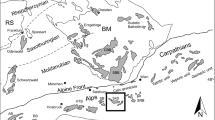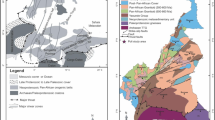Abstract
The study area is covered by quartz diorites, monzogranites, and pegmatites. Geochemically, the monzogranites and pegmatites have peraluminous to slightly metaluminous calc-alkaline to alkaline affinity, emplaced in volcanic arc setting and crystallized under moderate water-vapor pressure (3–5 kb) and temperature of 800–850 °C for monzogranites and 700–750 °C for pegmatites. The monzogranites reveal small to moderate negative Eu anomaly (Eu/Eu* = 0.62 to 1.0) and averages Eu/Sm = 0.168 and light rare earth elements (LREEs)/heavy rare earth elements (HREEs) = 48.78. The pegmatites reveal moderate to large negative Eu anomaly (Eu/Eu* = 2.39 to 2.96) patterns and have averages Eu/Sm = 0.075 and LREEs/HREEs = 32.22. The monzogranites are altered along two fracture zones exhibiting propylitic, silicification and record high radioactive measurements. These alterations cause enrichment in SiO2, Fe2O3 t, Ni, Y, V, Co, Th, and REEs except Er and depletion in Al2O3, TiO2, CaO, MgO, Na2O, K2O, P2O5, Cu, Zn, Cr, Zr, Rb, Ba, Pb, Sr, Nb, Ga, Hf, Cs, Li, Sn, Be, Sc, U, and Ta. The normalized chondrite pattern denotes moderate REEs fractionation and shows a narrow range fractionation of HREEs in both fresh, altered monzogranites and pegmatites. The studied fresh and altered monzogranites do not show tetrad effect, while the pegmatites show tetrad effect. The average eU content in fresh monzogranites is 5.55 parts per million (ppm), and the average U content is 5.03 ppm, whereas the average eTh content is 18.93 ppm, and the average Th content is 20.90 ppm. The average eU content in pegmatites is 14.76 ppm, and the average U content is 4.75 ppm, whereas the average eTh content is 57.02 ppm, and the average Th content is 15.30 ppm. The eU and eTh in the alteration zones reach up to 16.50 and 296.20 ppm, respectively. These high radioactivities are attributed to the presence of thorite, bastnäsite, fluorite, and columbite.































Similar content being viewed by others
References
Akaad MK, Noweir, AM (1980) Geology and lithostratigraphy of the Arabian Desert Orogenic Belt of Egypt between latitudes 25° 35′ and 26° 30′ N. In evolution and mineralization of the Arabian-Nubian Shield, 4, 127-136
Anders E, Grevesse N (1989) Abundance of the elements: meteoritic and solar. Geochim Cosmochim Acta 53:197–214
Basta FF (1983) Geology and geochemistry of the ophiolitic mélange and other rock units in the area around and west of Gabal Ghadir, Eastern Desert, Egypt. Ph.D. thesis, Cairo University, 137p
Bau M (1996) Controls on the fractionation of isovalent trace elements in magmatic and aqueous system; evidence from Y/Ho, Zr/Hf and lanthanide tetrad effect. Contrib Mineral Petrol 123:323–333
Boynton WV (1984) Geochemistry of the rare earth elements: meteorite studies. In: Henderson P (ed) Rare earth element geochemistry. Elsevier, Amsterdam, pp 63–114
Clarke MB (1981) The mineralogy of peraluminous granites: a review. Can Contrib Miner Petrol 79:3–17
Clarke SP Jr., Peterman ZE Heier KS (1966) Abundances in uranium, thorium and potassium. In Handbook of physical constants, Geological society of America, Memoir 97:521–541
Cullers RL, Graf JL (1984) Rare earth elements in igneous rocks of the continental crust: intermediate and silicic rocks—ore petrogenesis. In: Henderson P (ed) Rare earth element geochemistry. Elsevier, Amsterdam, pp 275–316
Cuney M, Leroy J, Volivezo A, Daziano C, Gambda B, Zarco AJ, Morello D, Ninci C, Molina, P (1989) Metallogenesis of the uranium mineralized Achala granitic complex, Argentina: comparison with Hercynian peraluminous leucogranites of West Europe. Proc. Tech. Comm. Meetings, Vienna, TECDOC-453, I. A. E. A. Vienna, 211–232
Deer AW, Howie RA, Zussman J (1962) Rock forming mineral, non-silicate, 5. Longman, London, p 371
De La Roche H, Leterrier J, Grandelaude P, Marchal M (1980) A classification of volcanic and plutonic rocks using R1–R2 diagram and major element analyses. Its relationships with current nomenclature. Chem Geol 29:183–210
Dixon TH (1981) Age and chemical characteristics of some pre-African rocks in the Egyptian shield. Precambrian Res 14:119–133
El-Gaby S (1975) Petrochemistry of some granites from Egypt. N Jb Mineral (Abh) 124:147–189
El-Manharawy MS (1977) Geochronological investigation of some basement rocks in Central Eastern Desert, Egypt between Lat. 25o and 26oN [D]. Unpub. Ph. D. thesis, Cairo University, Egypt. 216 p
El-Ramly MF, Akaad MK (1960) The basement complex in the central Eastern Desert of Egypt between lat. 24° 30′ and 25° 40′ N. Geol Surv Egypt 6, 19p
El-Sharkawy MA, El-Bayoumi RM (1979) The ophiolites of Wadi Ghadir area, Eastern Desert. Ann Geol Surv Egypt 9:125–134
El-Shazly EM (1964) On the classification of the Precambrian and other rocks of magmatic affiliation in Egypt. 22 Inter Geol Congr Proc Sect 10, India, 88–101
Erlank AJ, Marchant JW, Cardoso MP, Ahrens LH (1978) Zirconium. In: K. H. Wedepohl (ed) Handbook of geochemistry. Springer, Berlin, 2 (4), 40 p
Green TH (1995) Significance of Nb/Ta as an indicator of geochemical processes in the crust–mantle system. Chem Geol 120:347–359
Hashad AH (1980) Present status of geochronological data on the Egyptian basement complex. Inst Appl Geol Bull Jeddah 4:31–46
Hassan MA, Hashad AA (1990) Precambrian of Egypt. In: Said R (ed) The geology of Egypt. Balkena, Rotterdam, pp 201–245, 722 p
Heier KS (1973) Geochemistry of granulite facies rocks and problems of their origin. Philos Trans R Soc Lond Ser 273:429–442
Heinrich EW (1962) Radioactive columbite. Am Mineral 47:1363–1379
Hume WF (1935) Geology of Egypt. Vol. 2, part 2. The later plutonic and intrusive rocks. Geol. Surv. Egypt. Government Press, Cairo, pp 301–688
Hussein AA, Aly MM, El-Ramly MF (1982) A proposed new classification of the granite of Egypt. J Volcanol Geotherm Res 14:187–198
Ibrahim IH, Ali MA (2003) The granitic rocks in Wadi Ghadir area, South Eastern Desert, Egypt and occurrence of a secondary uranium mineral. Egypt J Geol 47(2):671–687
Irber W (1999) The lanthanide tetrad effect and its correlation with K/Rb, Eu/Eu*, Sr/Eu, Y/Ho and Zr/Hf of evolving peraluminous granite suites. Geochemica et Cosmochimica Acta 63(3):489–508
Irber W, Forster HJ, Hech L, Moller P, Mortteani G (1997) Experimental, geochemical, mineralogical and oxygen isotope constrain in the late magmatic history of the Fichtelgebirge granites (Germany). Geol Rdesch 86:110–124
Jahn BM, Wu F, Capdevila R, Martineau F, Zhao Z, Wang Y (2001) Highly evolved juvenile granites with tetrad REE patterns: the Woduhe and Baerzhe granites from the Great Xing and Mountains in NE China. J Liths 59:171–198
Kröner A, Todt W, Hussein IM, Mansour M, Rashwan AA (1992) Dating of Late Proterozoic ophiolites in Egypt and the Sudan using the single grain zircon evaporation technique. Precambrian Res 59:15–32
Lee SG, Masuda A, Kim HS (1994) An Early Proterozoic leuco granitic gneiss with the REE tetrad phenomenon. J Chem Geol 114:59–67
Linnen RL, Keppler H (1997) Columbite solubility in granitic melts: consequences for the enrichment and fractionation of Nb and Ta in the earth's crust. Contrib Mineral Petrol 128:213–227
Luth WC, Jams RH, Tuttle OF (1964) The granite system at pressure of 4 to 10 kilobars. J Geophys Res 69:759–773
Mason B (1966) Principles of geochemistry, 3rd edn. Wiley, New York, 239 p
Masuda A, Kawakami O, Dohmoto Y, Takenaka T (1987) Lanthanide tetrad effects in nature: two mutually opposite types, W and M. J Geochem J 21:119–124
Meyer CH, Hemley TT (1967) Wall rock alteration. In: Barnes HG (ed) Geochemistry of hydrothermal ore deposits. Holt, Rinehart Winston, New York, pp 166–235
Newberry RJ, Burns LE, Swanson SE, Smith TE (1990) Comparative petrologic evolution of the Sn and W granites of the Fairbanks-Circle area, interior Alaska. In: HJ Stein, and JL Hannah (eds.) Ore-bearing granite systems; petrogenesis and mineralizing processes. Geolo. Society of America Special Paper, 121–142
Ni Y, Hughes JM, Mariano AN (1993) The atomic arrangement of bastnäsite-(Ce), Ce(CO3)F, and structural elements of synchysite-(Ce), and parasite-(Ce). Am Mineral 78:415–508
Pearce JA, Harris NBW, Tindle AG (1984) Trace element discrimination diagrams for the tectonic interpretation of granitic rocks. J Petrol 25:956–983
Stemprok M (1979) Mineralization granites and their origin. Episodes 3:20–24
Stern RJ, Hedge CE (1985) Geochronological and isotopic constraints on Late Precambrian crustal evolution in the Eastern Desert of Egypt. Am J Sci 285:97–127
Streckeisen AL (1976) To each plutonic rocks its proper name. Earth Sci Rev 12:1–15
Stuckless JS (1979) Uranium and thorium concentrations in Precambrian granites as indicators of a uranium province in central Wyoming. Contrib Geol Univ Wyo 17(2):173–178
Sylvester P (1989) Post collision alkaline granites. J Geol 97:261–280
Takla MA, Basta FF, Shenouda HH, and El-Maghraby AM (1992) Geochemistry of gneisses and granitoids of Wadi Ghadir area, Eastern Desert, Egypt. GAW. Cairo Univ. I, 477–489
Taylor SR, Emeleus CH, Exley CS (1956) Some anomalous K/Rb ratios in igneous rocks and their petrological significance. Geochim Cosmochim Acta 10:224–229
Taylor SR, McLennan SM (1985) The continental crust: its composition and evolution. Blackwell, Oxford, 312 p
Terada Y, Nakai I, Kawashima T (1993) Crystal structure of bastnäsite (Ce, La, Nd, Sm, Gd) CO3F. Anal Sci 9:561–562
Tischendorf, G (1977) Geochemical and petrographic characteristics of silicic magmatic rocks associated with rare-element mineralization. In: Stemprok, M. Burnol, L. and Tischendorf, G. (eds) Metalization associated with acid magmatism. 2, 41–96
Tuttle OF, Bowen NL (1958) Origin of granite in the light of experimental studies in the system Na Al Si3O8–K Al Si3O8–SiO2–H2O. Geol Soc Am Mem 74:153
Watson E, Harrison TM (1983) Zircon saturation revisited: temperature and composition effects in a variety of crustal magma types. Earth Planet Sci Lett 64:295–304
Weaver B, Tarney J (1984) Empirical approach to estimating the composition of the continental crust. Nature 310:575–577
Wood DA, Tarney J, Varet J, Saunders AD, Bougault H, Treuil M, Cann JR (1979) Geochemistry of basalts drilled in the North Atlantic by IPOD Leg 49: implication for mantle heterogeneity. Earth Planet Sci Lett 42:77–97
Zaraisky GP, Aksyuk AM (2005) Petrogenesis of Rare Metal Calc-Alkaline Granites. In: Proceedings of 10th All-Russia Petrographic Conference. Petrography of the 21th Century. Petrol. and Ore Potential of CIS Regions and the Baltic Shield, Apatity, Russia, (Apatity, 2005), 93–95
Zaraisky GP, Aksyuk AM, Devyatova VN, Udoratina OV, Chevychelov VY (2008) Zr/Hf ratio as an indicator of fractionation of rare metal granites by the example of the Kukulbei Complex, Eastern Transbaikalia. Petrology 16(7):710–736
Zhenhua Z, Masuda A, Shabani MB (1993) REE tetrad effects in rare-metal granites. J Chin J Geochem 12:206–219
Acknowledgments
The author would like to express his gratitude to Prof. Dr. Abdu A. El-Sayed and Prof. Dr. Gehad M. Saleh for their helpful comments and suggestions.
Author information
Authors and Affiliations
Corresponding author
Rights and permissions
About this article
Cite this article
Kamar, M.S. Geochemistry and mineralizations of the Wadi Ghadir younger granites and associated pegmatites, South Eastern Desert, Egypt. Arab J Geosci 8, 1315–1338 (2015). https://doi.org/10.1007/s12517-014-1307-0
Received:
Accepted:
Published:
Issue Date:
DOI: https://doi.org/10.1007/s12517-014-1307-0




